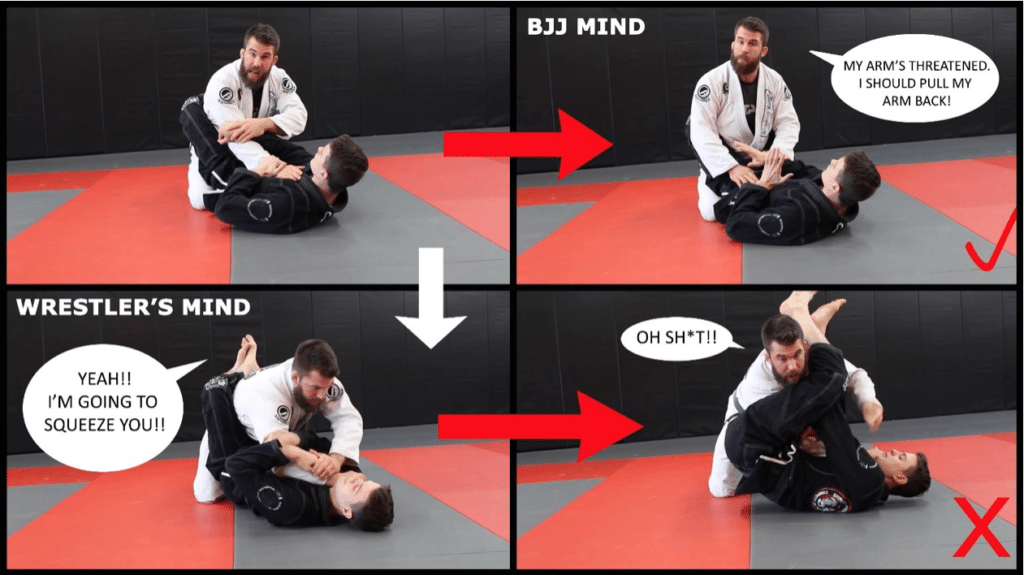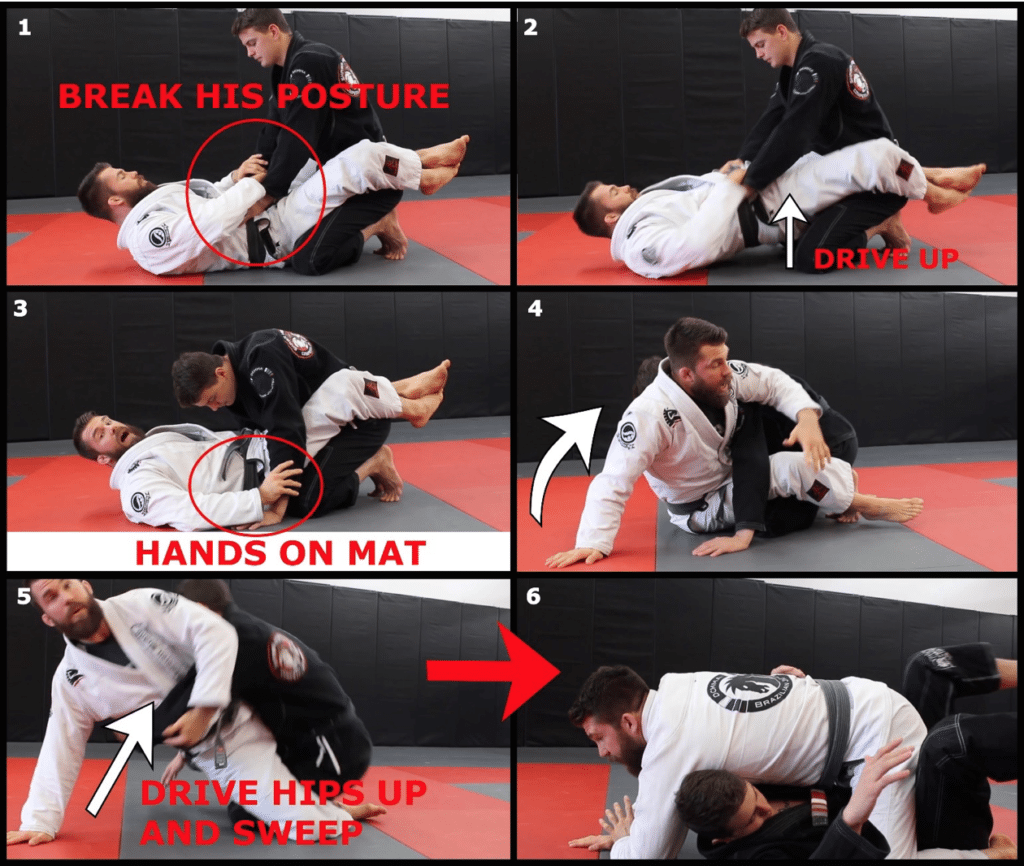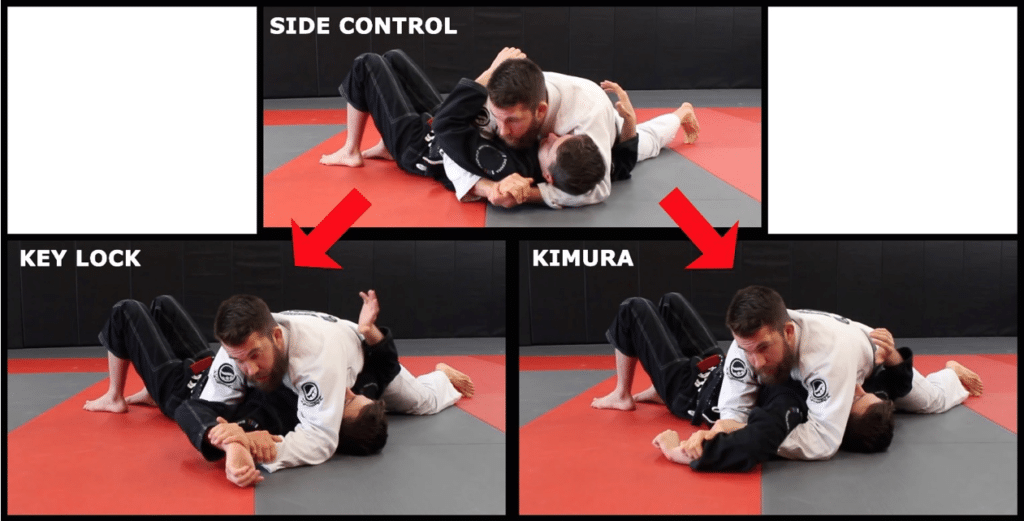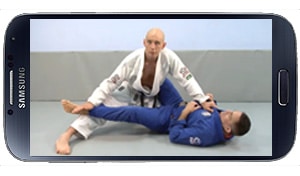Wrestling is a fantastic background for anyone who wants to train BJJ. The powerful takedowns, the determined scrambling, the level of conditioning and a tough mindset are a winning combination that work in any combat sport.
But transitioning from wrestling to BJJ and combining the best of both arts isn’t necessarily an easy process…
In fact it can be downright difficult and frustrating!
I recently asked Nick Albin, better known as ‘Chewy’, to share his thoughts on this topic. Chewy is now a BJJ black belt, but he came into the sport with a strong wrestling background, so he understands the trials and tribulations you’re going to face (check out my podcast with Chewy here).
In the video below Chewy shares,
- The best process for combining BJJ and wrestling,
- How to get used to being on your back,
- Mindset and pacing shifts that a wrestler needs to make, and
- The best sweeps and submissions for a wrestler to use in BJJ class.
Check out the video below…
Before going into the techniques and conceptual ideas, the first thing you have to understand is that you’re doing BJJ. Although wrestling and BJJ are different sports, they have techniques that are similar and yet different.
So don’t hold on to the identity of being a wrestler when you’re doing Jiujitsu.
Wrestler’s Frustration with the Gi in BJJ
Don’t refuse to wear the Gi, don’t avoid playing from your back and don’t just focus on taking people down and holding them. Engage in the activity on its own terms.
One of the biggest frustration for wrestlers getting into BJJ is the gi because of the grips and the unfamiliarity of it. Nick was the same way and he even made excuses of how the gi affected his performance and that he would’ve performed better with no gi.
But the gi is a great training tool if you use it and embrace it. So if you get into BJJ from a wrestling background and you find that the gi is a little frustrating, stop making excuses for yourself about why this is problematic.
Instead start thinking about solutions. It will make you ask better questions like:
- How did they get the gi choke?
- Why did that escape didn’t work because of the gi?
- What kind of grips are getting in the way?
- How can I get out of those grips?
- Can I set up the techniques better?
Making Friends with the Guard Position in BJJ
The other biggest frustration for most wrestlers is playing from the closed, open or half guard.
Wrestlers are ingrained to think being on your back is bad, because getting pinned flat in Wrestling ends the match regardless of whether you have the other guy in the guard or not.
But now in BJJ you have to realize that you’re in a situation where being on your back can be a good thing.
If a wrestler is in the guard with his arm isolated then it’s a bad thing. Here he doesn’t have any submission options whereas the guy on the bottom is actually in an offence position.

In a fighting situation, of course, the guy on top can throw punches which changes things. But in BJJ being trapped in the guard is a disadvantage.
In the early stages of transitioning from wrestling to BJJ Chewy made the mistake of feeling too comfortable sitting in his opponent’s guard. Then, all of the sudden, he would be getting submitted because he had no idea what his opponent was doing.
Think of BJJ and grappling as a language with the body. If the opponent is grabbing your arm, his body is telling you something and if you don’t understand the dialect, you can’t interpret that your arm is being threatened.
As a wrestler, you probably have good takedowns, but don’t just kick yourself away and go for a takedown when you’re put on your back.
You need to make sure that you’re really good from your back because you’re going to find yourself there if your opponent has really good sweeps or you’re against a better opponent.
By learning the bottom game, you’ll be able to predict your opponent’s move when you’re on top. Therefore, you want to be versatile; make a mental note to yourself to work on your guard when you train. Most of the high level BJJ practitioners can typically play top or bottom.
A Good Sweep for Wrestlers to Start With: The Hip Bump Sweep
It’s not all bad news; fortunately there’s a lot of carryover from wrestling that also works in BJJ.
For example, if you wrestle, you’re certainly familiar with the hip heist, a move most often used to escape and reverse the referee’s position.
But the BJJ hip bump sweep involves the same hip drive and turning movement used for the hip heist in wrestling.
You can see Chewy go through the steps of the hip bump sweep in the video above or the photos below, but basically they are as follows…
- First break his posture using your legs and hands. The goal is to get his hands to the floor which is your opening because your hips are free to move.
- Now open your guard, come forward and sit up while bringing one arm over his shoulder.
- You can sit up to your elbow but sitting to your hand gives you that few extra inches of drive to knock the person over.
- Drive your hips up, lifting your hips off the ground and turn towards the trapped arm. Sweep him and end in the mount!

Tempo and Pacing in BJJ vs Wrestling
A wrestler needs to understand the the tempo of jiu-jitsu is slower.
The action in wrestling is pretty fast and furious because the stalling calls come quick. If you don’t move, move, move you’re going to get penalised. But stalling calls don’t really exist in BJJ, and thus, you don’t have to go on a wrestler’s pace.
In fact you can’t always go full tilt. For example, passing guard requires a lot of energy so once you get to your side control, slow down, block the opponent’s hip that’s closest to you and breathe. Don’t tire yourself out too quickly.
It can be counter-intuitive for a wrestler, but side mount is where you catch your breath, evaluate your situation, and strategise in Jiujitsu.
Best Starting Submissions for a Wrestler in BJJ
If you’ve wrestled then you’re naturally going to be comfortable with pinning someone. However, there’s no pinning in BJJ so you need to add submissions into that equation.
First find some attacks from side control. This will give you a home base to attack from in the beginning. As you grow you’ll learn a multitude of different attacks from that position.
To start with though, the arms of the opponent are not too far for you in side control, so learning how to do the key lock and the Kimura armlock (and their setups) will serve you well!

Embrace the fact that you are doing Jiujitsu for what it is! Hopefully, these tips will help you with your transition.
If you haven’t heard The Strenuous Life Podcast Episode 120 with Chewy and Stephan talking about wrestlers adapting to jiujitsu, click the link to give it a listen.
Stephan Talks to Chewy from Chewjitsu on The Strenuous Life Podcast about the Intersection between #BJJ and #Wrestling Episode 120 https://t.co/2X5xU7Cbta via @StephanKesting
— StephanKesting (@StephanKesting) May 3, 2018
Learn BJJ For Free On Your Smartphone?!?
Would you like some help with the fundamental positions, attacks, escapes and strategies of BJJ?
The free Roadmap for BJJ app contains Stephan Kesting’s entire system for learning Brazilian Jiu-Jitsu fast. Grab this app for your iPhone, iPad, Android device or Kindle and watch as the pieces of the puzzle immediately start coming together for you. Click here to learn more about the Roadmap for BJJ App
The post Combining BJJ and Wrestling with ‘Chewy’ from Chewjitsu appeared first on Grapplearts.




